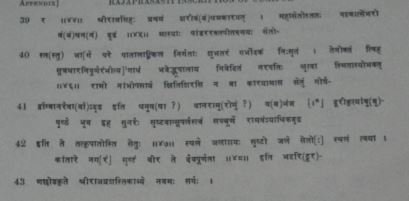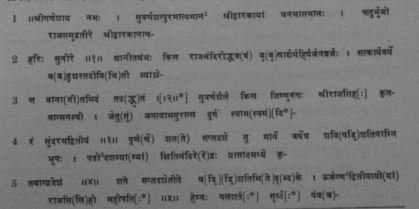| |
South
Indian Inscriptions |
| |
|
|
|
Contents |
|
Index
|
|
Introduction
|
|
Contents
|
|
List of Plates
|
|
Additions and Corrections
|
|
Images
|
|
Contents |
|
Chaudhury, P.D.
|
Chhabra, B.ch.
|
|
DE, S. C.
|
|
Desai, P. B.
|
|
Dikshit, M. G.
|
|
Krishnan, K. G.
|
|
Desai, P. B
|
|
Krishna Rao, B. V.
|
|
Lakshminarayan Rao, N., M.A.
|
|
Mirashi, V. V.
|
|
Narasimhaswami, H. K.
|
|
Pandeya, L. P.,
|
|
Sircar, D. C.
|
|
Venkataramayya, M., M.A.,
|
|
Venkataramanayya, N., M.A.
|
|
Index-By A. N. Lahiri
|
|
Other
South-Indian Inscriptions
|
|
Volume
1
|
Volume
2
|
|
Volume
3
|
Vol.
4 - 8
|
|
Volume 9
|
Volume 10
|
|
Volume 11
|
Volume 12
|
|
Volume 13
|
Volume
14
|
|
Volume 15
|
Volume 16
|
|
Volume 17
|
Volume 18
|
|
Volume
19
|
Volume
20
|
|
Volume 22
Part 1
|
Volume
22
Part 2
|
|
Volume
23
|
Volume
24 |
|
Volume
26
|
Volume 27 |
|
Tiruvarur
|
Darasuram
|
|
Konerirajapuram
|
Tanjavur |
|
Annual Reports 1935-1944
|
Annual Reports 1945- 1947
|
|
Corpus Inscriptionum Indicarum Volume 2, Part 2
|
Corpus Inscriptionum Indicarum Volume 7, Part 3
|
|
Kalachuri-Chedi Era Part 1
|
Kalachuri-Chedi Era Part 2
|
|
Epigraphica Indica
|
Epigraphia Indica Volume 3
|
|
Epigraphia
Indica Volume 4
|
Epigraphia Indica Volume 6
|
|
Epigraphia Indica Volume 7
|
Epigraphia Indica Volume 8
|
|
Epigraphia Indica Volume 27
|
Epigraphia Indica Volume 29
|
|
Epigraphia Indica Volume 30
|
Epigraphia Indica Volume 31
|
|
Epigraphia Indica Volume 32
|
Paramaras Volume 7, Part 2
|
|
Śilāhāras Volume 6, Part 2
|
Vākāṭakas Volume 5
|
|
Early Gupta Inscriptions
|
|
Archaeological
Links
|
|
Archaeological-Survey
of India
|
|
Pudukkottai
|
|
|
EPIGRAPHIA INDICA

Slab XI ; Canto X
[Metres : vv. 1-4, 10-12, 16-19, 22-25, 27, 28, 30, 31, 37-39 Upajāti ; vv. 5-7, 9, 13-15, 20, 21,
33-36, 40-43 Anushṭubh ; v. 8 Sragdharā ; vv. 26, 29, 32 Indravajrā.]

_______________________________________________________________
[1] The portion within the square brackets, i.e., from gē to tya was first omitted by the engraver through oversight, who afterwards added it at the end in the last line, indicating the addition by the kākapada signs.
[2] This pāda is short of one syllable. The letter śa appears more like rā. Perhaps the intended reading is
Suvarṇaśailāt=puri bhāty=amānaḥ.
[3] Paḍō-daśamī here is only the form in local dialect of Pāṇḍu-daśamī in l. 39, p. 51, and means the tenth day
of the yellow month, i.e., Māgha. Mr. Shaktidhar Guleri informs me that padu-pañchamī and paḍu-daśamī are
observed as festivals in Kāngrā on the 5th and 10th days respectively of the bright-half of Māgha.─N.P.C.
[4] Read Ūrjaḥ-kṛishṇa- ; the first word meaning Kārttika.
|
\D7
![]()
|







